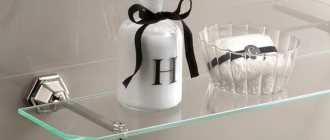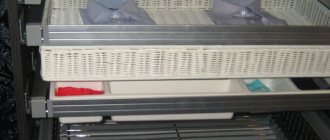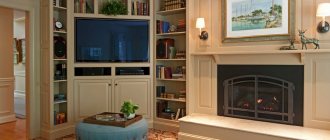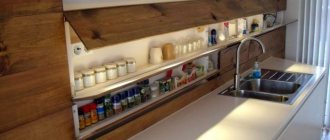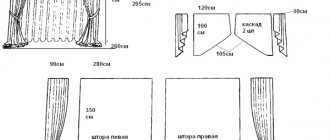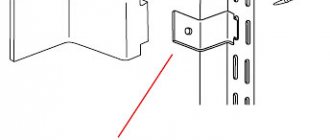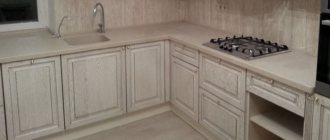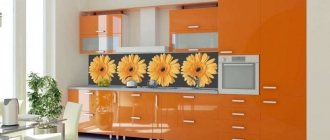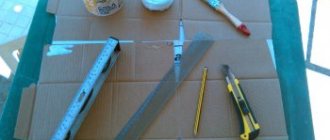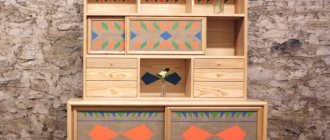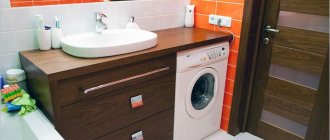/Furniture/Set, wardrobe, rack/
Wall shelves can open up new storage options or provide a cute backdrop for home decor. Small and large, book and kitchen, with hidden fastening and cantilever - almost any shelves can be made with your own hands, rather than bought in a store. In this material, we presented 3 simple and budget-friendly ways to make shelves for various purposes, as well as 70 photo ideas for inspiration.
Assembling a wooden structure
Even a novice craftsman with minimal carpentry skills can make a wooden wall shelf from boards with his own hands. To assemble a simple model, you don't need complex woodworking tools. To complete the work quickly, prepare the necessary equipment in advance and draw up a sketch of the future design.
The shelf is part of the interior and can be decorated in any style. In order for it to complement the design of the room, you need to think about the shape and material from which it will be made.
Required tools and materials
Wood is a universal structural material that does not require professional carpentry equipment to process. All parts are cut from a solid board or sheet lumber (plywood, chipboard, MDF).
For assembly you will need:
- Wooden planks. Their number and dimensions depend on the chosen design, method of fastening, and the expected weight that the shelf must withstand.
- Fasteners Self-tapping screws, screws, and embedded elements are needed to connect the parts together and secure the frame.
- Decoration materials. The finished shelf is painted, varnished or a textured film is glued to the front surfaces.
- Glue. To increase the strength of the joints of the parts, they are coated with an adhesive compound (PVA or carpentry).
To get the job done quickly, you should use carpentry hand and power tools. If the necessary equipment is not at hand, you can ask friends or rent it. To assemble the shelf you will need:
- Jigsaw or circular saw. The latter is more preferable - when cutting, the cut will be smooth, without bends.
- A screwdriver with a set of drills and bits for screwing fasteners.
- Grinding machine with replaceable sanding cloths of 60, 120, 240 grains per square centimeter.
- Grinder with sharpening wheel and metal brush.
- Electric planer.
Drawing up a diagram, marking
The manufacture of a shelf begins with drawing up a sketch of the future design. A simple diagram, made on an approximate scale, will allow you to calculate the area of the workpieces, their number, and attachment points. The resulting dimensions are transferred to boards or sheets of lumber. Marking is done using metal meter rulers or tape measures and even wooden blocks.
When transferring dimensions, allowances are left for processing the ends if the edges of the workpieces crumble during cutting. This happens especially often when cutting plywood or chipboard. Before assembly, the allowances are cut off with a plane with a sharp blade or cleaned off with a grinding machine. When forming the final dimensions, check the perpendicularity of the ends to the base surfaces using a mechanic's or carpenter's square.
The correct shape of the workpieces can be controlled by measuring the diagonals. For a rectangle they should be equal.
Material cutting
After applying the markings, they begin cutting the lumber into blanks. To do this, use a circular hand saw or jigsaw. If they are not available, you can use a regular hacksaw with fine teeth. In addition, it is possible to cut and glue the edges of laminated chipboard at the point of purchase using professional equipment. The blanks obtained in this way will be of the correct shape with the required parameters. Then all that remains is to assemble the piece of furniture on site.
Assembly
When the craftsman has everything he needs, he can proceed directly to assembling the frame. Progress:
- The cut workpieces are cleaned and burrs are removed.
- At the locations of the fasteners, holes are drilled with a diameter slightly larger than the size of the hardware.
- The parts are laid out on the floor or other flat surface, forming the outline of the future shelf. The joints are lubricated with glue and the components are tightened with self-tapping screws.
- Weak spots are reinforced with metal staples.
- Brackets for hidden wall mounting are screwed onto the back side.
- The finished structure is opened with decorative coatings. If the shelf is made of laminated chipboard with glued edges, it does not need additional processing.
Required Tools
You can't assemble a shelf with your bare hands. We will talk about the tool that is useful for making a shelf below.
1) The very first woodworking tool that comes to mind is a jigsaw, but just a hand saw will do. A jigsaw is a convenient, dexterous, fast tool; with its help, blanks for a shelf will be made in a matter of minutes.
2) A grinding machine or sandpaper of different abrasiveness will help to sand the surface of each part of the shelf. A sanding machine will cope with this task quickly, unlike skins, which take time to work with.
3) Electric drill - helps to drill holes both in the components of the shelf and in the wall for fastening.
4) Screwdrivers or screwdriver - needed to screw in self-tapping screws, connecting the component parts of the shelf to each other. Evaluate the advisability of using a screwdriver if you need to tighten four self-tapping screws. You can handle them with a screwdriver.
5) Self-tapping screws, screws, confirmats - connecting elements. Upon completion of work on the shelf, they are masked with plugs matched to the color of the shelf.
6) Varnish for coating wood - this coating must be of high quality. The shelf will be used regularly, so its appearance should be preserved as long as possible. We recommend an alkyd wood varnish with a urethane additive, which provides strength.
7) Paint brush – necessary for applying paint and varnish coatings to the surface of the shelf. Choose a medium-sized brush.
 A square is a special measuring tool, the design of which has a right angle. It allows you to check and position the shelf parts relative to each other at right angles. If you don’t have a square in your arsenal of tools, you can use available tools: ceramic tiles, a sheet of cardboard, a photo frame, etc.
A square is a special measuring tool, the design of which has a right angle. It allows you to check and position the shelf parts relative to each other at right angles. If you don’t have a square in your arsenal of tools, you can use available tools: ceramic tiles, a sheet of cardboard, a photo frame, etc.
9) Hand router – this tool will help you decorate a shelf with patterns and give straight lines a non-standard shape. Decorative patterns will make the shelf even more beautiful.
You don’t have to rack your brains and go on a trip to furniture stores so as not to find something that might suit you.
How to make a hanging shelf
Purchase three pieces of wood from a home improvement store, or measure and mark three pieces of 1" x 8" pine by 18" long (Image 1). Cut them at home using a circular saw (Image 2). If necessary, sand any rough edges.
Turn all the boards upside down. Using a tape measure, mark 1" horizontally and vertically from each corner on all three boards (Image 1, 2). This is where the holes for the rope and grommets (also called nylon spacers) will go. These grommets will be hidden from view but will help hold the shelves in place so you don't have to deal with a lot of knots.
Next, have a 1-inch shovel ready with masking tape to act as a depth adjuster to ensure you don't drill too deep into the bottom of each shelf (Image 1). You need to drill deep enough so that each plastic sleeve fits flush and is hidden from view. Tape the drill so that only 3/8" of the tip is exposed (Image 2). Align the point of the spade with the pencil mark and drill down slowly to avoid going too deep (Image 3). (The sharp tip of the bit will go through the other side a little, but that's okay.) Repeat until all 12 holes are completed. Note:
Once you're done, resist the urge to stick the grommet in there. how can it get stuck?
Then flip the three boards right side up and, using the small hole as a guide (Image 1), replace the spade bit with a regular 3/8" drill bit and drill through (Image 2). Repeat until all 12 holes are completed (Image 3) .
After preparing all the holes, paint the primed boards. While they are drying, move on to the next step.
Using a 1/16" drill bit, drill through each of the 12 plastic bushings (Image 1). Then drill the same hole using a countersink drill bit so that when you add the screws later, the screws will fit. flush with the side of the bushing (Image 2).
Our shelf was about 34 inches tall, so we used two 7-foot pieces of rope—one for the front and one for the back. You can customize it according to your sizes. Note:
Threading the rope through the holes will be much easier if you wrap the ends with masking tape.
Then assemble the shelf by passing the rear cable
first through the top shelf and then through the grommets so that the rope and shelf are centered and hanging securely from something. You can go ahead and hang it in place or temporarily on something so you can easily make changes. (We used a scrap piece of cardboard with a screw.) Then pass the front rope through each side of the top shelf (Image 1), then its grommets (Image 2, 3) and let the front piece go through each side of the top shelf (Image 1), then through it bushings (Image 2, 3). The rope is still hanging freely.
It is important to take the time to adjust the top shelf so that it reaches the desired height using the back rope. Once you have determined the correct height of the top shelf on the rope, slowly drive small #4 3/4" screws into each grommet using drill, pushing the screw through the back cable and into the other side of the bushing (Image 1). Since you used a countersink bit, the screw should lie flat and the bushing should slide up easily into the hole you drilled in the bottom of the board. Repeat this step on the other side of the shelf/back rope. Then focus on the front cables and get the top shelf fully level before moving on (Image 2), screw the screws into the grommet/rope, then slide the shelf down onto the grommet so the shelf is at the desired height and level. Once you have that " just like that”, you can measure the distance from this top shelf so that the bottom shelves are positioned correctly and level (Image 3).
Once the bottom shelf is hung, tie the ropes into a knot on both sides (Image 1), then cut them with a utility knife (Image 2). For an interesting texture, you can part the ends of the ropes to create a fringe (Image 3). Now you are ready to hang the shelf; just make sure you use the right hardware and anchors. Note:
If you hang a shelf in the bathroom, the steam will help the rope straighten a little over time.
Master class No. 1: hanging shelf
If you have a lot of souvenirs, figurines and other decorative elements stored in your room, make an original and convenient hanging shelf on ropes to display them. The big advantage of this design is that you don’t have to drill many holes in the wall to attach it - just one nail in the ceiling is enough.
To work you will need:
- 2 rectangular wooden blanks;
- skin (coarse and fine);
- drill;
- drill;
- rope;
- scissors;
- construction clamps;
- materials for decorating the product - brushes, paints, leftover wallpaper (to the taste of the master).
Having prepared the necessary tools, you can get to work.
- We make preparations. Wood is a material that is very easy to work with. The main thing is to choose boards that are perfectly smooth, dry, without mold, voids or cracks. Then there will be no problems processing them. Go over the prepared boards with sandpaper, first coarse, then fine. File the edges with a hacksaw.
At your discretion, the shelves can be painted or covered with stain and varnish, and covered with remnants of old wallpaper. Having chosen to paint, treat the wood with an antiseptic primer in advance. The paint adheres to it better, and the service life of the product increases.
- We make holes. Place both shelves together and secure with construction clamps. If there are no clamps, make holes on each shelf separately. The main thing is that they are located strictly under each other in the same places. The size of the drill should be selected based on the diameter of the rope - it should fit freely into the holes.
- We measure the rope. You will need four ropes of the same size. Determine their length yourself, depending on how far from the ceiling you plan to hang the shelf. Don't forget to add a few centimeters for tying knots.
- Assembling the shelf. Tie a knot on each rope (the bottom shelf will rest on them). Pass the free ends through the holes and tie them in a knot again - the crossbar will be fixed. Measure the distance to the second shelf and secure it in the same way as the first. Check that the distance from knot to knot is the same on all ropes.
- Securing the shelf. The last step is to tie all the ropes at the end with a secure knot and secure it to the ceiling. If the length is not enough, tie additional rope to the knot.
Your wall shelf is ready. All that remains is to place your favorite things on it.
Types of shelves
Shelves perform many functions and are used for different purposes. In this regard, shelves can be presented in the form of hanging structures or niches, attached in several ways, and made of different materials.
Kinds
| Variety | Description |
| Wall mounted | As the name suggests, they are attached to the walls. Place it above the sofa, bed or next to the table. |
| Hanging | Attached to the ceiling using chains, cables or belts. Often used in the living room, bedroom, kitchen. |
| Corner | Hang at the junction of two walls and attach to the walls or ceiling. A universal option for any room. |
Shelves are completely different both in appearance and functionality.
You can store things, books or place decorative elements on the shelves
Form
Shelves are available in a wide range, differing in:
- shape, size, color;
- surfaces (smooth, glossy, matte or textured);
- style orientation;
- functionality (stands, lighting).
Design
The variety of existing shelf designs will delight everyone who decides to add new elements to their home. After all, this will help create a unique interior design and surprise everyone with unusual shelves that can:
- be with side walls or without them at all;
- be located horizontally or vertically relative to the wall;
- have several tiers or move to the sides;
- have right angles or have a rounded shape.
Shelves can be of completely different shapes and designs
Using shelves you can significantly update the interior of a room.
Shelves in the kitchen are designed for storing kitchen utensils or decorative items.
Material
The advantage of this product is that it is made from various materials:
- metal;
- tree;
- glass (transparent, frosted or colored);
- MDF;
- chipboard;
- plastic;
- a combination of two or more materials at once.
Hanging flower stand
Also a hanging shelf for flowers, only narrow, in “one pot”. These pots are convenient to hang in a corner or in a narrow place where a large shelf will not fit. You can decorate your veranda with similar “garlands”; they will look especially beautiful in a room with high ceilings.
If you like the idea, you can choose one of the options in this small selection.
Decoration
Decoration is an equally important stage in the manufacture of bookshelves. Of course, you can leave it in the original video, but to add sophistication and uniqueness to your creation, you can use minimal decorative elements.
Let's say the front parts of the shelves are covered with thin gold or silver strips, which are sold in all stores where decorative elements are offered. Gold goes better with light-colored wood, and for dark shelves you can choose silver. You can also use fabric and rope covers.
Decorative patterns will make the shelf even more beautiful.
The option of applying drawings to the side parts of the shelf is also possible.
Drawings are applied with paint. They are made in the form of a mosaic from scrap materials (coffee, shells, rope). Visit a decorative store and you will realize that decorating a shelf is easy.
We install the resulting structure with its lower part on the table and screw the upper part to the sides.
What you will need
To make hanging shelves with your own hands you will need:
- wooden boards - 3 pcs.;
- strong twisted rope - a large skein;
- flanges - 2 pcs.;
- galvanized pipes with threads on both sides - 3 pcs. (one long, 2 short);
- galvanized elbows;
- tape measure, level, wood clamps;
- drill;
- sandpaper and grinder;
- stain and brush;
- screws or wall anchors;
- universal glue and glue gun.
Making balls as decorative elements
Stages of work:
- Inflate the balloon to the desired diameter.
- Lubricate the string with glue. To do this, apply drops of glue at a distance of several centimeters from each other, and then rub over the surface of the rope, without smearing it along the entire length. An end that is too long, smeared with glue, may dry out while it is not yet wound onto the ball. Starting from the middle of the ball, wrap the entire surface with twine greased with glue, without adhering to any order in winding. In this case, there should be gaps between the individual threads, as well as a hole for removing the ball.
- Leave the ball to dry. Drying time depends on the amount of glue used. After proper drying, the ball should retain its shape when pressed on its surface.
- Carefully coat the dried product with varnish.
- Puncture the balloon and remove it from the finished product.
Such crafts can be of different sizes and colors. As an independent decoration, these interesting products can transform the interior of a room. Similar ideas can be used when making decor in the form of a vase for dried flowers or flowerpots.
Decorative and original
Often, shelves on the wall play a purely decorative role.
They are designed to attract attention and this goal is achieved by an unusual shape, contrasting with the walls and color. You can’t bet much on it: one or two things, but how interesting they are. Another interesting topic is glass shelves
Just one glass is not very interesting. Its combination with wood and steel is more attractive. The effects are sometimes unexpected. Glass is assembled on guides: the material is fragile and heavy, and it needs to be held. Steel can do it
Another interesting topic is glass shelves. Just one glass is not very interesting. Its combination with wood and steel is more attractive. The effects are sometimes unexpected. Glass is assembled on guides: the material is fragile and heavy, and it needs to be held. Steel can do this.
An interesting glass option. You can arbitrarily change the height between tiers
In fact, these systems are intended for creating store interiors, but they also look stylish in an apartment in a modern or loft style.
Also suitable for vintage style
What are shelves made of? Even from pipes. Metal and plastic. Do you have any samples left from the renovation? Put it to work and get a designer item, interestingly, assembled from trash.
There are examples that simply amaze you. Well, how could you come up with this?
